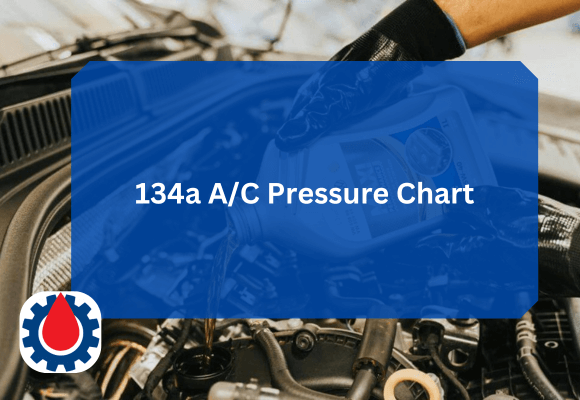If your car’s air conditioning isn’t cooling as it should, one of the first things to check is the refrigerant pressure. Most modern vehicles use R-134a refrigerant, which has a specific pressure range depending on temperature.
Understanding and using a 134a A/C pressure chart helps you diagnose low refrigerant, leaks, or compressor issues quickly and accurately.
134a A/C Pressure Chart
| Ambient Temperature (°F) | Low-Side Pressure (PSI) | High-Side Pressure (PSI) |
|---|---|---|
| 50°F | 25–30 | 110–160 |
| 55°F | 26–31 | 120–170 |
| 60°F | 28–32 | 130–190 |
| 65°F | 30–34 | 150–210 |
| 70°F | 32–36 | 165–220 |
| 75°F | 35–40 | 175–240 |
| 80°F | 40–45 | 190–250 |
| 85°F | 45–50 | 210–270 |
| 90°F | 45–55 | 225–290 |
| 95°F | 50–55 | 250–310 |
| 100°F | 50–60 | 275–325 |
| 105°F | 55–65 | 290–340 |
| 110°F | 60–70 | 300–350 |
| 115°F | 65–75 | 325–375 |
| 120°F | 70–80 | 340–400 |
| 125°F | 75–85 | 360–420 |
| 130°F | 80–90 | 380–440 |
| 135°F | 85–95 | 400–460 |
| 140°F | 90–100 | 420–480 |
| 145°F | 95–105 | 440–500 |
| 150°F | 100–110 | 460–520 |
| 155°F | 105–115 | 480–540 |
| 160°F | 110–120 | 500–560 |
| 165°F | 115–125 | 520–580 |
| 170°F | 120–130 | 540–600 |
Related Car AC PSI Chart(Complete Guide)
How to Use the 134a A/C Pressure Chart
1. Check Ambient Temperature:
Measure the outside temperature near your vehicle.
2. Connect the A/C Manifold Gauges:
Attach the low-side (blue) hose to the service port on the larger A/C line and the high-side (red) hose to the smaller line.
3. Start the Engine and Turn on A/C:
Set it to maximum cooling and let it stabilize for a few minutes.
4. Read Pressures:
Compare your readings with the chart above.
5. Interpret the Results:
- Low pressure too low: May indicate undercharging or restriction in the orifice tube.
- Low pressure too high: Possible overcharge or faulty compressor.
- High pressure too high: Airflow restriction or condenser fan issue.
- Both low and high sides low: System undercharged or compressor not engaging.
Related Car AC Gauge Reading Chart(Complete Guide)
Common 134a A/C Pressure Problems
| Condition | Low-Side (PSI) | High-Side (PSI) | Likely Cause |
|---|---|---|---|
| Low/Low | 0–25 | 50–150 | Low refrigerant or compressor not running |
| Low/High | 20–35 | 250–400 | Blocked condenser, bad fan, or overcharge |
| High/High | 50–70 | 300–400 | System overcharged or airflow blocked |
| Normal/Low | 25–35 | 125–175 | Weak compressor |
| Low/Normal | 10–25 | 175–225 | Orifice tube or expansion valve stuck open |
| Normal/Normal | 30–45 | 200–250 | System operating correctly |
Related AC System Pressure Chart(For All Refrigerant Types)
Tips for Maintaining Correct A/C Pressure
1. Always Use the Right Refrigerant
Only use R-134a for systems designed for it. Using R-12 or R-1234yf will cause damage.
2. Do Not Overcharge
Adding too much refrigerant can increase pressure beyond safe levels, stressing the compressor.
3. Replace the Receiver/Drier When Servicing
This component removes moisture and contaminants. It should be replaced when the system is opened.
4. Check for Leaks Regularly
Use UV dye or an electronic leak detector. Small leaks reduce performance over time.
5. Keep Condenser Clean
Dirt and debris restrict airflow, raising high-side pressure and reducing cooling efficiency.
Related AC Vent Temperature Chart(Complete Guide)
Signs of Incorrect A/C Pressure
- Weak or warm airflow from vents
- Intermittent cooling (works then shuts off)
- Compressor clutch cycling frequently
- Hissing sound under the hood after shutdown
- Frost on A/C lines or evaporator
FAQs
What are normal AC pressures for R134a?
Normal operating pressures for R-134a refrigerant depend on ambient temperature. Typically, the low-side pressure should be between 25–45 PSI, and the high-side pressure should range from 200–250 PSI at an ambient temperature around 75–85°F.
Always refer to a 134a A/C pressure chart to match the correct pressure with the outside temperature for accurate readings.
What happens if 134a pressure is too high?
If the R-134a pressure is too high, it can cause the compressor to overwork, leading to excessive heat and potential system damage. High pressure usually results from overcharging, restricted airflow across the condenser, or non-condensable gases in the system. Symptoms include poor cooling performance, compressor noise, or A/C clutch cycling rapidly.
What is the normal pressure for AC gas?
For most automotive systems using R-134a, the normal pressure is:
- Low side (suction): 25–45 PSI
- High side (discharge): 200–250 PSI
- These values can fluctuate depending on outside temperature and humidity. The refrigerant gas pressure should always be checked against the ambient temperature using the correct chart.
Is 40 psi too much for AC?
A low-side pressure of 40 PSI is generally acceptable for R-134a systems when the ambient temperature is around 80°F or higher. However, if it’s cooler outside and the pressure is 40 PSI, that might indicate overcharging or a weak compressor. Always cross-reference the reading with the 134a A/C pressure chart to ensure proper levels.
How to check R134a pressure?
To check R-134a pressure:
- Connect a manifold gauge set or A/C recharge kit to the low and high service ports.
- Start the engine and turn the A/C to maximum cooling.
- Let it run for several minutes to stabilize.
- Read the low- and high-side pressures from the gauges.
- Compare your readings to the temperature-pressure chart to determine if the system is undercharged, overcharged, or operating normally.
What causes low side AC pressure too high?
High pressure on the low side can indicate several issues:
- Overcharged refrigerant
- Faulty expansion valve or orifice tube
- Compressor not compressing efficiently
- Air or moisture contamination in the system
- Condenser airflow blockage
- Diagnosing this correctly requires reading both sides of the system and checking refrigerant flow and temperature balance.
What is the pressure for R134a at 30 degrees?
At 30°F ambient temperature, R-134a should have a pressure of around 26–28 PSI on the low side and approximately 90–110 PSI on the high side.
However, most A/C systems do not operate efficiently at such low temperatures since the refrigerant pressure and system response are affected by cold conditions. Always ensure the A/C is tested at a moderate ambient temperature for reliable results.




